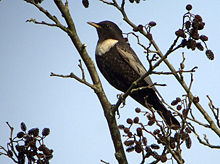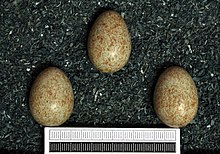Ring throttle
| Ring throttle | ||||||||||||
|---|---|---|---|---|---|---|---|---|---|---|---|---|

Ring Thrush ( Turdus torquatus ) |
||||||||||||
| Systematics | ||||||||||||
|
||||||||||||
| Scientific name | ||||||||||||
| Turdus torquatus | ||||||||||||
| Linnaeus , 1758 |
The ring thrush ( Turdus torquatus ) is a songbird from the thrush family (Turdidae).
description
The ring thrush is very similar to the blackbird (black thrush) in size and structure. The male has black plumage, a black scaly underside with white borders and a very noticeable white broad stripe on the chest. The male's lower beak is orange. In the female, the color tends towards brown and the breast stripe is light gray. The body reaches a size of about 24 to 26 centimeters. The juvenile plumage of the young birds does not yet show a stripe on the breast, but is spotted. The singing sounds like "tack ... tack" or "trüh ... trüh".
habitat
The ring owl prefers light coniferous forests in higher low mountain ranges and in the Alps , but mountain, spruce and moor forests in Northern Europe are also popular destinations. It has its winter quarters in the Mediterranean area from November to February.
nutrition
The ring ossuary feeds on mollusks , berries , insects and their larvae , but the earthworm is at the top of the menu .
Reproduction
The typical thrush nest is built by the female quite low on conifers and bushes made of twigs, stalks , grass, roots and moss . The four to five blue-green and brown-spotted eggs are warmed for two weeks in the April to August breeding season. The young birds fledge after 12 to 14 days.
Web links
- Turdus torquatus in the endangered Red List species the IUCN 2008. Posted by: BirdLife International, 2008. Accessed January 31 of 2009.
- Videos, photos and sound recordings of Turdus torquatus in the Internet Bird Collection
- Age and gender characteristics (PDF; 0.9 MB) by Javier Blasco-Zumeta and Gerd-Michael Heinze (English)
- Springs of the ring throttle

